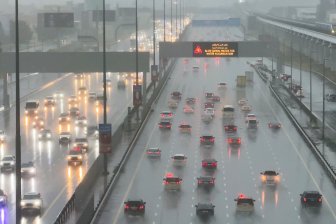Warning: Some of the details in this story may be disturbing to some readers. Discretion is advised.

When the bodies of 215 children were found at the site of a former B.C. residential school, Shirley Williams says that at first, she was “OK.”
Then the flashbacks started, and Williams was brought back to her own time spent in a residential school.
“They hid bodies. Even though they were nuns and priests and things like that, you know, they did things that were not proper,” Williams, who is now in her 80s, told host Bill Kelly in an interview aired on 900 CHML’s Bill Kelly Show.
Many Canadians speak about residential schools, and the abuse children like Williams were put through, as a tragic part of Canada’s past. Even Prime Minister Justin Trudeau, upon learning about the discovery of the bodies of over 200 children in Kamloops, called it a “dark and shameful chapter of our country’s history.”
But for Indigenous people living in Canada, the residential schools are not in the past. The impact of residential schools continues to be felt right now in a number of ways — from the internalized shame taught in school and passed down to younger generations, to the ongoing separation of families in the foster care system, according to advocates.
“What I’ve been hearing is, ‘Oh, get over it.’ You know, psychologically, it had an impact on Native children. I’m a human being,” Williams said.
“It doesn’t leave a person until there is healing or some kind of restitution to make that person become whole again.”

Williams remembers her dad fighting to keep her at home. He angrily argued with an Indian agent that Williams, who was seven years old, should not be sent to a residential school until she turned 10. He succeeded and won three more years with his daughter.
But when she turned 10, Williams was ripped from her home and sent to a residential school in Joseph, Ont..
“I was scared because I was alone, but my sisters already prepared me for what I would encounter and what they were going to do,” said Williams, who is now in her 80s.
At her residential school, the nuns would ring a bell. The bell would tell her when to move, when to get up, when to kneel, when to pray. That bell, she said, “almost destroyed” her.
Girls would be struck so hard they had to be sent to bed, Williams recalled. Then the bell would ring.
“We would be off to school when the bell rang … and we wouldn’t see the girl again,” William said.
“And they would say, ‘Well, they took her to the hospital.’ That’s all they said. We never knew what happened to that girl.”
The last residential school closed its doors for good in 1996. But advocates say the assimilationist policies children like Williams faced continued with a new face: that of the foster care system.
Foster care in Canada: a new residential school?
“It’s this concept of removal and institutionalization that has continued. It’s just got a different name on it,” said Pam Palmater, a Mi’kmaq lawyer, professor and activist.
Over half of the children in foster care are Indigenous, according to figures from the federal government. That’s despite Indigenous people making up just over seven per cent of the under-14 population in Canada.
The conditions that cause so many Indigenous kids to land in the child welfare system are “related to the intractable legacies of residential schools including poverty, addictions, and domestic and sexual violence,” according to a Truth and Reconciliation Commission report.
“Canadian children are far more likely to be apprehended and put into foster care for reasons of physical and sexual abuse than Indigenous children,” Palmater said.
Almost half of the instances where Indigenous kids are found to be mistreated are attributable to neglect, while roughly a third are due to witnessing intimate partner violence, according to the Canadian Child Welfare Research Portal (CWRP).
Meanwhile, for non-Indigenous children, direct abuse is much more common. Over 23 per cent of confirmed cases of mistreatment are attributed to physical abuse while three per cent are linked to sexual abuse, according to CWRP.

“The majority of (Indigenous children) are apprehended and put in care for reasons around poverty and systemic disadvantage, not physical or sexual abuse, which is the racist stereotype that’s perpetuated,” Palmater said.
On top of that, some Indigenous children are taken away at birth, before the mother even gets a chance to prove she’s fit to take care of her baby.
“And what happens to many of these foster care children? Well, they’re far more likely to be physically or sexually abused, (they) lack access to their own culture. They’re cut off from their communities, their families,” Palmater said.
It doesn’t stop there. As these Indigenous children grow up, they’re also far more likely to be incarcerated. Indigenous adults accounted for 31 per cent of Canada’s incarcerated population in 2018-19, despite making up just 4.5 per cent of the Canadian adult population.

The foster care system functions as a sort of “pipeline” to incarceration, according to a 2018 report from the Ontario Human Rights Commission.
“Compared to youth from the general population, youth from the child welfare system are also at much greater risk for becoming involved with the juvenile criminal justice system, a process referred to as the “child-welfare-to-prison pipeline,” the commission wrote.
“Because of racial disparities in the child welfare system, Indigenous and Black children may be disproportionately likely to experience these negative effects.”
Being placed in care also makes Indigenous youth face higher rates of homelessness, lower incomes, higher unemployment rates and chronic child health problems, the commission wrote. All those issues can set the stage for their own children being removed, placed into foster care, and the cycle starts all over again.
“You’re talking about multiple ongoing traumas that are happening today, even to residential school survivors. So this is by far not a thing of the past,” Palmater said.
“We’re continuing on with this genocidal process without addressing it. So it is by no means in the past. That’s just a way of trying to absolve current responsibility for it.”
Internalized lessons loom over descendants
The ongoing impact of residential schools doesn’t just rear its head in the form of the foster care system.
After years of schooling that taught Indigenous children to reject their culture and that destroyed their self-worth, generations of Indigenous children internalized the effects, according to Sheila North, who is the former Grand Chief of Manitoba Keewatinowi Okimakanak.
North’s mother attended a residential school, and the messages her mother internalized were passed along to North, too.
“It strips away people’s self-worth. And then when they (become) parents, they treat people the way they have been treated, unconsciously,” North said.
“And our elders and our knowledge keepers call this blood memory. (They) remember the good and the bad of what happened to people, to themselves. And then they pass it on to their future generations.”
North explained that because her parents were taught in residential school to think they were inferior to non-Indigenous people, they passed on those “underlying messages” during her childhood.
“I carry that throughout my whole life. I still have to catch myself sometimes.”

While riding an elevator once with her aunts and uncles in high school, North said they were all laughing and speaking in Cree. But then a white person stepped on the elevator, and all the lessons passed on to North from her mother’s time spent in a residential school filled the air.
“We all kind of went to the wall and we didn’t speak Cree at all. We spoke in our broken English because we didn’t want this random stranger white person in here to think that we were dumb and that we were in the way,” North said.
“Those kinds of messages and even worse ones are being generated and passed down from one generation to another.”
North said she hopes to try to stop passing these subconscious messages down the family tree.
“I want to break that cycle going forward with my grandson,” she said.
How settlers can help break the cycle
Non-Indigenous Canadians have a role to play in ending the legacy of residential schools, North said.
Just as she works to challenge her own feelings of low-self worth and remind herself to take up space, North believes non-Indigenous Canadians have to remember to allow Indigenous people into that space.
“The only way to break the cycle is to really understand what has happened, and then move forward to make decisions for yourself not to perpetuate the systems,” North said.
“And by that, I mean, you could be a position where you’re in charge of hiring. Are you using your bias to hire certain people over others? You know, in Winnipeg here, we have a high Indigenous population. We don’t see a lot of Indigenous kids and young people, or … any age, working in retail or service industries, because we’re not being hired.”
She said non-Indigenous Canadians need to read about the impacts of policies like residential schools and pass that knowledge onto their peers.
“Start sharing it with the people around you. You have a lot of people around you that look up to you and value what you say. You have a circle of influence and you can influence them to understand what has happened,” North said.
“I think that’s the only way we’re going to create change, is create spaces for other people. And it’s okay to enjoy your privilege, but also, do something good with it.”
The Indian Residential Schools Crisis Line (1-866-925-4419) is available 24 hours a day for anyone experiencing pain or distress as a result of their residential school experience.




Comments